Episode 402: The Hoop Snake and Friends
Description
Thanks to Nora and Richard from NC this week as we learn about some scary-sounding reptiles, including the hoop snake!
Further reading:
The Story of How the Giant “Terror Skink” Was Presumed Extinct, Then Rediscovered
San Diego’s Rattlesnakes and What To Do When They’re on Your Property
Snake that cartwheels away from predators described for the first time
Giant new snake species identified in the Amazon
The terror skink, AKA Bocourt’s terrific skink [photo by DECOURT Théo – Own work, CC BY-SA 4.0, https://commons.wikimedia.org/w/index.php?curid=116258516]:
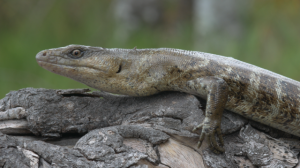
The hoop snake according to folklore:
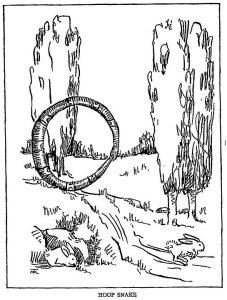
The sidewinder rattlesnake [photo taken from this article]:
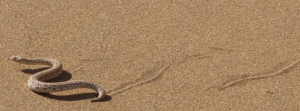
The dwarf reed snake [photo by Evan Quah, from page linked above]:
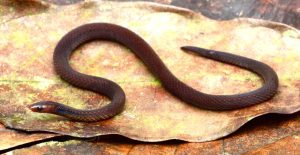
The green anaconda [photo by MKAMPIS – Own work, CC BY-SA 4.0, https://commons.wikimedia.org/w/index.php?curid=62039578]:
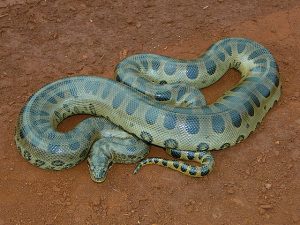
Show transcript:
Welcome to Strange Animals Podcast. I’m your host, Kate Shaw.
As monster month continues, we’re going to look at some weird and kind of scary, or at least scary-sounding, snakes and lizards. Thanks to Nora and Richard from NC for their suggestions this week!
We’ll start with the terror skink, whose name should inspire terror, but it’s also called Bocourt’s terrific skink, which is a name that should inspire joy. Which is it, terror or joy? I suppose it depends on your mood and how you feel about lizards in general. All skinks are lizards but not all lizards are skinks, by the way.
The terror or possibly terrific skink lives on two tiny islets, which are miniature islands. These islets are themselves off the coast of an island called the Isle of Pines, but in French, which I cannot pronounce. The Isle of Pines is only 8 miles wide and 9 miles long, or 13 by 15 km, and is itself off the coast of the bigger island of New Caledonia. All these islands lie east of Australia. Technically the islets where the skink lives are off the coast of another islet that is itself off the coast of the Isle of Pines, which is off the coast of New Caledonia, but where exactly it lives is kept a secret by the scientists studying it.
The skink was described in 1876 but only known from a single specimen captured on New Caledonia around 1870, and after that it wasn’t seen again and was presumed extinct. Colonists and explorers brought rats and other invasive animals to the New Caledonian islands, which together with habitat loss have caused many other native species to go extinct.
But in December 2003, a scientific expedition studying sea snakes around the New Caledonian islands caught a big lizard no one recognized. Once the expedition members realized it was a terror skink, alive and well, they took lots of pictures and videos of it and then released it back into the wild. Since then, more specimens have been discovered during four different expeditions, but only on the islets, not on any of the bigger islands. It’s so critically endangered that its location has to be kept secret, because if someone captures some of the lizards to sell on the illegal pet market, the species could easily be driven to extinction.
The terror skink is gray-brown with darker stripes, a long tail, and a slightly downturned mouth that makes it look grumpy. It grows about 20 inches long, or 50 cm, including its tail. This is really big for a skink, so technically it’s a giant skink.
It gets the name terror skink from its size and from its teeth, which are large and curved like fangs. It mainly eats one particular species of land crab, which is why its jaws are so strong and its teeth are so sharp, so it can bite through the crab’s exoskeleton.
Another lizard with a spooky name that has been presumed extinct is the gray ghost lizard, suggested by Richard from NC. It’s more properly called the giant Tongan ground skink, and it’s native to some more South Pacific islands—specifically, the Tongan Islands. These islands are even farther east from Australia than the New Caledonian islands, and are actually closer to New Zealand than to Australia, although they’re not really very close to either.
The giant Tongan ground skink was described in 1839 from two specimens collected in the late 1820s on Tongatapu Island. They’re the only two specimens known and the lizard is considered extinct, especially considering that these days, the island is almost completed deforested and rats, dogs, and cats have been introduced to it, which has driven many species to extinction.
But after the terror skink was rediscovered, scientists started to wonder if the gray ghost might still be around. It was called the gray ghost because it was so hard to see, since it was dark gray in color. The native Tongan people considered it a good omen if someone saw one, since it was so rare.
A paper published in early 2024 suggests that the gray ghost might be living on some smaller islands where forests still remain, and also suggested that it might be nocturnal and a burrowing skink. That would explain why it was so rarely seen by the people who lived on its island when it was still alive.
We know basically nothing about the gray ghost. Hopefully an expedition to the smaller Tongan islands will rediscover it so we can learn more about it and protect it.
Richard from NC also suggested we talk about the hoop snake, an animal of folklore. I remember reading about it as a kid in a book about American folklore animals, most of which were clearly jokey and not meant to seem real. The hoop snake sounded more realistic.
The hoop snake was supposed to be a long, slender snake that slithered around normally most of the time, but when it needed to move faster, it would grab the end of its tail in its mouth and roll like a wheel, or a hoop. Some versions of the story had the snake rolling along with the tip of its tail pointed forward, and since the tail was supposed to be sharp and venomous, it would roll after you so fast that when its tail stabbed you, you’d drop dead. The only way to escape would be to jump behind a tree. The





